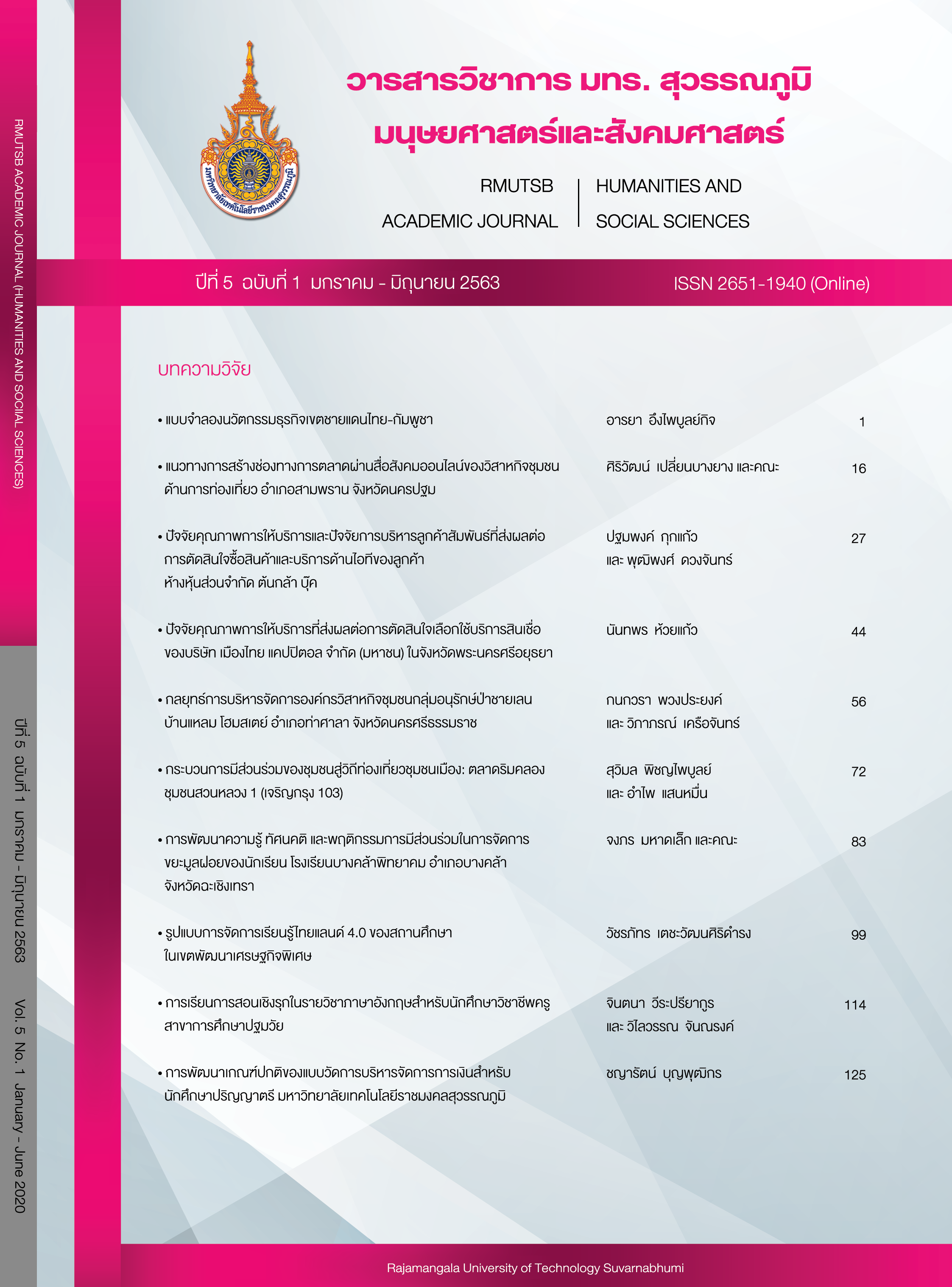The Thai-Cambodian border business innovation model
Main Article Content
Abstract
The objectives of this study was to develop a business innovation model for Thai-Cambodian border. The samples were from small and medium enterprises in Burirum, Surin and Sisaket province, total of 600 people. This research study used purposive sampling for selecting the samples. The researcher collected the data from March to July 2019 by questionnaires. Data were analyzed by Structural Equation Modeling: SEM. Findings from the research suggested that the simulations of business innovation model for Thai-Cambodian border are consistent with the empirical data and the factors directly influenced the innovation consisted of intellectual capital, market orientation and learning organization. Moreover, innovation, intellectual capital, market orientation and learning organization showed direct positive influence on performance.
Article Details
References
Adriansyah, A., & Afiff, A. Z. (2015). Organizational culture, absorptive capacity, innovation performance and competitive advantage: An integrated assessment in Indonesian banking industry. The South East Asian Journal of Management Seam, 9(1), 70-86.
Aini, E. K., Shen, D. C. L., Al Musadieq, M., & Hanayani, S. R. (2013). The role of innovation capability on business performance at small medium enterprises. Journal Profit, 7(1), 101-110.
Angsuchote, S., Vijitwanna, S., & Phinyopanuwat, R. (2015). Statistical analysis for social science research and behavioral: Techniques for using LISREL (4th ed.). Bangkok: Rongphim Charoendi Mankhong Kanphim.
Bartes, F. (2009). Paradigma Inovací a Hodnotové inženýrství. Brno: VUT.
Department of Foreign Trade. (2019). Statistics of border trade and border trade in Thailand 2016-2018. Department of Foreign Trade, Ministry of Commerce. Retrieved July 20, 2019, from http://www.dft.go.th/bts/trade-report. (in Thai)
Frosen, J., Luoma, J., Jaakkola, M., Tikkanen, H., & Aspara, J. (2016). What counts versus what can be counted: The complex interplay of market orientation and marketing performance measurement. Journal of Marketing A head of Print, 80(3), 1-19.
Gebhardt, G. F., Gregory S. C., & John, F. S. (2006). Creating a market orientation: A longitudinal, multifirm, grounded analysis of cultural transformation. Journal of Marketing, 70, 37-55.
Glavas, A., & Mish, J. (2015). Resources and capabilities of triple bottom line firm: Going over old or breaking new ground? Journal Business Ethics, 127, 623-642.
Hana, U. (2013). Competitive advantage achievement through innovation and knowledge. Journal of Competitiveness, 5(1), 82-96.
Jardon, C. M., & Martos, M. S. (2012). Intellectual capital as competitive advantage in emerging clusters in Latin America. Journal of Intellectual Capital, 13(4), 462-481.
Kamukama, N., Ahiauzu, A., & Ntayi, J. M. (2011). Competitive advantage: Mediator of intellectual capital and performance. Journal of Intellectual Capital, 12(1), 152-164.
Khalique, M., Isa, A. H. B. M., & Shaari, J. A. N. B. (2013). Predicting the impact of intellectual capital management on the performance of SMEs in electronics industry in Kuching, Sarawak. The IUP Journal of Knowledge Management, 11(4), 53-61.
Khalique, M., & Hassan, A. (2014). Intellectual capital in SMEs operating in boutique sector in Kuching, Malaysia. The IUP Journal of Management Research, 8(2), 17-28.
Klimas, P. (2014). How objective are subjective measures of organizational innovativeness, really? Management and Business Administration, Central Europe, 22(2), 30-44.
Mutindi, U. J. M., Namusonge, G. S., & Obwogi, J. (2013). Effects of strategic management drivers on organizational performance: A survey of the hotel industry in Kenyan Coast. International Journal of Arts and Commerce, 2(11), 83-105.
Narver, J. C., & Slater, S. F. (1990). The effect of a market orientation on business profitability. Journal of Marketing, 54, 20-35.
Office of Small and Medium Enterprises Promotion. (2017). White paper on small and medium enterprises of Thailand in 2016. Bangkok. Bangkok: Thang Sa-Duak. (in Thai)
Osman, C. A., & Ngah, R. (2016). Assessing sustainable competitive advantage in relation with intellectual capital, knowledge management and innovativeness in woman-owned SMEs in Malaysia. Journal of International Business, Economics and Entrepreneurship, 1(1), 46-51.
Romero, I., & Martine-Roman, J. A. (2012). Self-employment and innovation. Exploring the determinants of innovative behavior in small business. Research Policy, 41(1), 178-189.
Safarzadeh, T., Dahghan, E., Pazireh, M., & Pouraskari, F. (2015). Checking the relationship between strategic leadership, competitive advantage and organizational performance with mediating role of innovation. International Journal of Business and Behavioral Sciences, 5(1), 11-18.
Talaja, A., Miocevic, D., & Alfirevic, N. (2017). Market orientation, competitive advantage and business performance: Exploring the indirect effects. DRUS. ISTRAZ. ZAGREB GOD., 26(4), 583-604.
Ueasin, N., & Kulalar, Y. (2018). A study of the trads situation of entrepreneurs at the Chong Chom border crossing point, Surin Province. Nakhon Phanom University Journal, 8(1), 19-27. (in Thai)
Uengpaiboonkit, A. (2017). The development of causal model of competitive advantage that affects the performance of SMEs in three province, Thailand. ASEAN Journal of Management & Innovation, 4(2), 9-20.
Wijayanto, A., Suhadak, A., Dzulkirom, M., & Nuzula, N. F. (2017). The effect of intellectual capital on financial performance of innovative manufacturing companies in Indonesia: The mediating effect of competitive advantage. In Proceeding The 3rd International Conference on Economics, Business, and Accounting Studies (ICEBAST) 2017. University of Jember: UPT Penerbitan Universitas Jember.
Yasin, G., Nawab, S., Bhatti, K., & Nazir, T. (2014). Relationship of intellectual stimulation, innovations and SMEs performance: Transformational leadership a source of competitive advantage in SMEs. Middle-East Journal of Scientific Research, 19(1), 74-81.
Zainul, M., Astuti, E. S., Arifin, Z., & Utami, H. N. (2016). The effect of market orientation toward organizational learning, innovation, competitive advantage, and corporate performance. Journal of Administrative Sciences and Policy Studies, 4(1), 1-19.
Zhou, K. Z., & Wu, F. (2010). Technological capability, strategic flexibility, and product innovation. Strategic Management Journal, 31, 547-561.
Zin, S. M., Mat, R. C., Manaf, K. A., Muhammad, N., Mansor, F. A., & Hashim, M. Z. (2018). Identifying importance-performance matrix analysis (IPMA) of intellectual capital and Islamic work ethics in Malaysian SMEs. Journal of Fundamental and Applied Sciences, 10(1S), 793-805.
Zulkifli, N. S., Shukor, Z. A., & Rahman, M. R. C. A. (2017). Intellectual capital efficiency and firm performance in Malaysia: The effect to government ownership. Asian Journal of Accounting and Governance, 8(Suppl.), 93-105.


